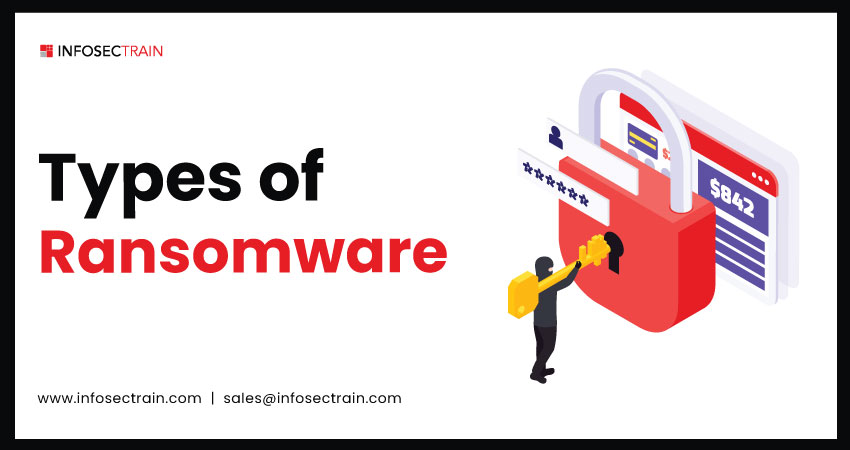Types of Ransomware
Ransomware, a malicious software, has become a prevalent and destructive cyber threat, causing chaos globally for individuals, businesses, and organizations. It encrypts files or denies access to systems, demanding a ransom for recovery. As the threat landscape evolves, different types of ransomware have emerged, each with distinct characteristics and modes of operation. This evolution highlights the need for proactive cybersecurity measures and awareness to combat this persistent threat.

Table of Contents
What is Ransomware?
Types of Ransomware
Tips to Safeguard Against Ransomware
What is Ransomware?
Ransomware is malicious software that encrypts files or locks users out of their systems, demanding payment for decryption or access. It typically spreads through phishing emails, malicious attachments, or exploit kits. Ransomware seriously threatens data security, often resulting in financial loss and operational disruptions. Effective cybersecurity measures, such as regular backups and up-to-date security software, are crucial for protection against ransomware.
Types of Ransomware
1. Crypto-Ransomware:
Crypto-ransomware, impacting Microsoft Windows systems, employs malware like Hive, REvil, and Ryuk to block computer access until a ransom is paid. Typically, hackers distribute malicious email attachments to initiate these attacks, encrypting the victim’s files upon opening. The hacker demands payment in cryptocurrency, such as Bitcoin, to hinder tracing. Despite payment, receiving the correct decryption key is not guaranteed or protected from future infections.
2. Scareware:
Scareware, affecting Android, macOS, and Microsoft Windows systems, utilizes software like Mac Defender and WinFixer to deceive users into downloading fraudulent products or services, granting cybercriminals access to their devices. In these attacks, users may inadvertently visit spoofed websites that trigger scare tactics through alarming pop-ups or fake security scan results, leading them to download malicious software.
3. Extortionware:
Extortionware targets Linux, macOS, Microsoft Windows, and some IoT devices, using software like EvilQuest and REvil. Unlike traditional ransomware, extortionware locks the victim’s device and threatens to expose private information unless a ransom is paid. Hackers exploit the information stored on the device, seeking company secrets or personal data to use as leverage for extortion.
4. Locker Ransomware:
Locker ransomware, targeting Microsoft Windows systems, utilizes software like CryptoLocker and Locky to forcibly eject the owner from their device rather than encrypting files. Cybercriminals often gain access through social engineering, convincing users to download malware. In locker ransomware attacks, all computer functions except the mouse and keyboard are disabled, allowing the victim to use the keyboard to make the demanded payment.
5. Wiper Malware:
Wiper malware affects Cloud services, Linux, Microsoft Windows, and macOS and utilizes software like Jigsaw, NotPetya, and KillDisk. Unlike other malware, wiper malware doesn’t just restrict access but threatens to destroy infected files, mainly targeting businesses, potentially halting operations. Often, perpetrators of wiper malware attacks do not demand a ransom, but if they do, it’s typically triggered by time-based mechanisms.
6. Doxware:
Doxware, affecting Android, cloud services, iOS, IoT devices, Linux, macOS, and Microsoft Windows, employs software like DoppelPaymer and REvil. Unlike typical ransomware, Doxware goes beyond file encryption, threatening to expose proprietary or personal information and risking identity theft and physical harm. In these attacks, businesses and individuals may be targeted, with repercussions often more severe due to hackers leveraging confidential data.
7. Mobile Ransomware:
Mobile ransomware has emerged with the rise of smartphones and tablets, targeting mobile operating systems like Android and iOS. It often disguises itself as legitimate apps or spreads through malicious links and attachments. Once installed, it can lock the device or encrypt stored files, demanding payment for release. Mobile ransomware poses unique challenges due to the variety of mobile platforms and the sensitive data stored on these devices.
Tips to Safeguard Against Ransomware
1. Regular Data Backups:
Ensure your data is consistently backed up on an offline storage device. This will allow for recovery in the event of a ransomware attack.
2. Access Control Measures:
Enforce stringent access controls to limit user permissions, preventing unauthorized installation of malicious software.
3. Software Maintenance:
Keep your operating system, applications, and security tools updated with the latest patches to address potential vulnerabilities exploited by attackers.
4. Reliable Security Solutions:
Use reputable antivirus and anti-malware software capable of identifying and blocking ransomware threats effectively.
5. Phishing Vigilance:
Exercise caution when encountering suspicious emails, attachments, or links. Avoid clicking on unrequested links or downloading files from unfamiliar sources.
Cybersecurity Training with InfosecTrain
Ransomware incidents have seen a significant rise in recent years. As a leading provider of information security training and consulting services, InfosecTrain offers an excellent opportunity to enhance your understanding of cybersecurity. Whether you are a beginner or an experienced professional, our platform enables you to embark on and complete your learning journey effortlessly. We provide both live instructor-led sessions and self-paced courses. Our Network Security training programs delve deeply into ransomware and effective defense strategies against it.







 1800-843-7890 (India)
1800-843-7890 (India)